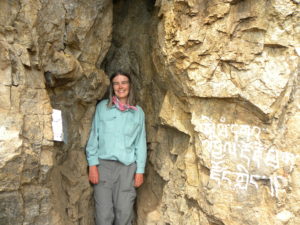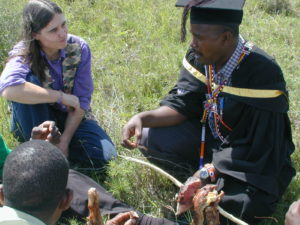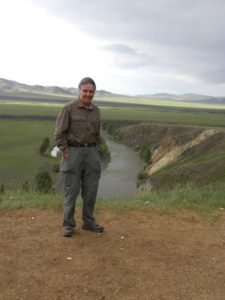Provost’s Council for Engagement spotlight: Robin Reid
by Jim Beers | June 9, 2017 3:28 PM
Editor’s note: The Provost’s Council for Engagement[1] is made up of a dozen faculty members representing all eight colleges and Morgan Library. Council members serve as champions for advancing the practice and recognition of engaged scholarship as fully embedded within Colorado State University’s core teaching, research and service missions. Each month we are profiling a different member of the Council, who will in their own words help to showcase the diversity of engaged scholarship across campus, as well as the impact of this engagement work on communities and the university. Four council members – Martin Carcasson[2], Christine Fruhauf,[3] Neil Grigg[4] and Bill Shuster[5] – have been profiled.

This month we meet Robin Reid, professor in the Department of Ecosystem Science and Sustainability[6] and director of the endowed Center for Collaborative Conservation.[7]
Reid spent 20 years in east Africa, working for CSU and then the International Livestock Research Institute in Nairobi, Kenya, where she led research, education and outreach on conservation and pastoral development issues in Africa, Latin America, and Asia.
She now leads work on how to make science a catalyst for transformative social action. Reid also works with teams on using collaborative action to make progress on complex problems of society and the environment in the western U.S., Mongolia and east Africa.
What, in your opinion, is “faculty engagement”?
“For me, faculty engagement is meaningful work with non-CSU partners, like government, the private sector, nonprofits, teachers and students, and citizens. This meaningful work is best designed with these partners so that the work is fully relevant to their needs. It often starts with a single, two-way partnership, but can grow to large and complex partnerships with significant joint impact over long periods of time and large areas. It is most useful when it brings teaching and research together with this ‘engagement’, so that we maximize the learning and impact that comes from this engagement.”
How have you, your program or students benefitted from what you have learned as an engaged faculty member? Has there been any sort of reciprocity or two-way learning with the communities outside of CSU that you have been involved with?

“We do all of our work at the Center for Collaborative Conservation (and my work in the Department of Ecosystem Science and Sustainability) in this engaged mode because we see it as the most effective way to build a more sustainable and just future for us all. We work constantly to get out of the ‘ivory tower’ and make a difference in the world, whether it is in Fort Collins, across Colorado, in the American West, or around the world.
This means that almost all of our work has a practical aspect and we develop all of our research with our partners, to answer urgent questions that they face. In fact, one primary area of our research is to study and innovate in how to transform our model of science to be more relevant.
All of our work (faculty, graduate students, undergraduate research, staff) focuses on two-way learning. For example, our research in East Africa focuses on how community-based conservation works and how it could work better in pastoral ecosystems.
We start all our work by co-developing the research questions with community members and policy-makers before we submit proposals for funding. We then fund members of our co-research team, whether they be at CSU or from the community. Sometimes this funding is in the form of salary, or field costs, or workshop costs.
We conduct the research as partners and co-produce the work together. In this process, we are often integrating local or indigenous knowledge with scientific knowledge, which means a huge amount of cross-cultural, cross-institutional and cross-language learning. We communicate the results of our work together and design our next research-with-action together. Our community partners often change their management strategies or policies in response to what we learn together (See article[8] for a specific example of this type of work).
We also use all of what we learn by developing these new models in the classroom. All of our teaching engages with communities in different parts of the world, so our students gain a practical and relevant understanding of how to solve real world problems.”
Why are you involved with this council and how does it related to your work or research?
“I am involved with this council because I think faculty and students at CSU do great work and we have significant examples of impact on society through our engagement outside the university, but this is hard work to do and it is often hard to figure out how to get started for new faculty, students and staff. So I want to help develop ways for faculty, students and staff to get even better at this engaged scholarship than they already are when working with partners outside the university.
I also think we have much more we can innovate at CSU. In a sense, CSU is perfectly positioned to lead in engaged scholarship and invent new ways to do this better. I think the council will help us reach that dream.”

What do you hope the council is able to accomplish?
“First, I think we are keeping our ‘light under a bushel’ at CSU and we need to get the stories of our current engagement out. This is job No. 1.
Second, I think we need to develop a network of engaged scholars across the university to learn from each other and take our work to the next level. This might be by sharing best practices or working together on joint projects.
Third, I think we need to work conceptually and in practice on developing new ways to do this engagement.
Finally, this is hard and time-consuming work. We need to develop better ways of recognizing, valuing and rewarding this work. This council can help us do that.”
Any other thoughts on the Provost’s Council for Engagement?
“This is truly an amazing group of people, so passionate and dedicated to making a difference in the world. It is a complete privilege to be part of this group and work together!”
- Provost’s Council for Engagement: http://source.colostate.edu/provosts-council-engagement-support-faculty-efforts/
- Martin Carcasson: http://source.colostate.edu/provosts-council-engagement-member-martin-carcasson/
- Christine Fruhauf,: http://source.colostate.edu/provosts-council-engagement-spotlight-christine-fruhauf/
- Neil Grigg: http://source.colostate.edu/provosts-council-on-engagement-spotlight-neil-grigg/
- Bill Shuster: http://source.colostate.edu/provosts-council-engagement-spotlight-bill-shuster/
- Department of Ecosystem Science and Sustainability: https://warnercnr.colostate.edu/ess/
- Center for Collaborative Conservation.: https://webcms.colostate.edu/collaborativeconservation/
- See article: http://www.pnas.org/cgi/doi/10.1073/pnas.0900313106
Source URL: https://source.colostate.edu/provosts-council-engagement-spotlight-robin-reid/
Copyright ©2024 SOURCE unless otherwise noted.